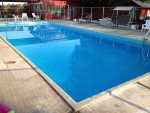- May 28, 2013
- 24
- Pool Size
- 35000
- Surface
- Plaster
- Chlorine
- Salt Water Generator
- SWG Type
- CircuPool RJ-60
My Grandfather built this pool in Northern California in 1958. It is on our farm and has served us wonderfully for the past 56 years. It was actually idle (emptied!) for around 7 years. There were small cracks that we ground grooves into applied caulking to and then plaster. We then used epoxy paint and it held for most of the last 3 summers. Each year around labor day the water starts to go down faster than evaporation. We empty it and do the same process. Ok... didn't really work. Below is what I've found out from old pictures and an exploratory dig into the shallow end.
1. The pool is 65' x 20', 9' deep in the deep end and probably 3.5' in the shallow end. The drain was covered many years ago. We have replaced all of the old galvanized pipe with PVC. New Pump. That is about it. The original 2 skimmers are intact and there is a "Vacuum port that sits about a foot or so under the level of the skimmers.
2. The deck is tied with rebar to the side of the pool. No expansion joint. The deck on one side is maybe 8 feet, the other side 20 feet. Step one is that I'm planning to cut an expansion joint into the deck so it is no longer attached to the pool.
3. There is a small crack that starts in the wall of the shallow end and goes the length of the pool, dissapating in the deep end.
4. We had considered jackhammering a 1' wide area around the crack and tieing into the existing rebar and repouring. We jackhammered an exploratory area and found there is not rebar in the floor, only wire mesh in 4" of concrete that is used in many driveways, etc...
5. There is original tile around the top of the pool, missing pieces. No Coping of any kind.
We had a consultant come out and this is what he recommended.
1. Cut the expansion joint in the deck, then tie into the existing rebar to "zipper" it.
2. After we found that there was only mesh and no rebar. He recommended to "guarantee a fix" would be to rebar and pour 4" concrete over the existing floor. Frankly, that sounds easier and sounds more reliable than the zipper.
Anyone have any input? Does that make sense? If so....
* Can we do the rebar and concrete pour right over the existing plaster? (Of course the paint needs to be sandblasted away.)
* What size rebar and what pattern?
* When we plaster over the floor, can we plaster to the existing plaster? Or do we have to plaster the whole pool?
* Or... is there another approach that is better?
I should have stated initially that we want to do most of this ourselves. And we would like to take as much of it in stages as we can. We really want to be sure of the water integrity before we go too much further. i.e. we'd like to plaster the floor, be sure of integrite and then finish the plaster and tile replacement.
1. The pool is 65' x 20', 9' deep in the deep end and probably 3.5' in the shallow end. The drain was covered many years ago. We have replaced all of the old galvanized pipe with PVC. New Pump. That is about it. The original 2 skimmers are intact and there is a "Vacuum port that sits about a foot or so under the level of the skimmers.
2. The deck is tied with rebar to the side of the pool. No expansion joint. The deck on one side is maybe 8 feet, the other side 20 feet. Step one is that I'm planning to cut an expansion joint into the deck so it is no longer attached to the pool.
3. There is a small crack that starts in the wall of the shallow end and goes the length of the pool, dissapating in the deep end.
4. We had considered jackhammering a 1' wide area around the crack and tieing into the existing rebar and repouring. We jackhammered an exploratory area and found there is not rebar in the floor, only wire mesh in 4" of concrete that is used in many driveways, etc...
5. There is original tile around the top of the pool, missing pieces. No Coping of any kind.
We had a consultant come out and this is what he recommended.
1. Cut the expansion joint in the deck, then tie into the existing rebar to "zipper" it.
2. After we found that there was only mesh and no rebar. He recommended to "guarantee a fix" would be to rebar and pour 4" concrete over the existing floor. Frankly, that sounds easier and sounds more reliable than the zipper.
Anyone have any input? Does that make sense? If so....
* Can we do the rebar and concrete pour right over the existing plaster? (Of course the paint needs to be sandblasted away.)
* What size rebar and what pattern?
* When we plaster over the floor, can we plaster to the existing plaster? Or do we have to plaster the whole pool?
* Or... is there another approach that is better?
I should have stated initially that we want to do most of this ourselves. And we would like to take as much of it in stages as we can. We really want to be sure of the water integrity before we go too much further. i.e. we'd like to plaster the floor, be sure of integrite and then finish the plaster and tile replacement.


